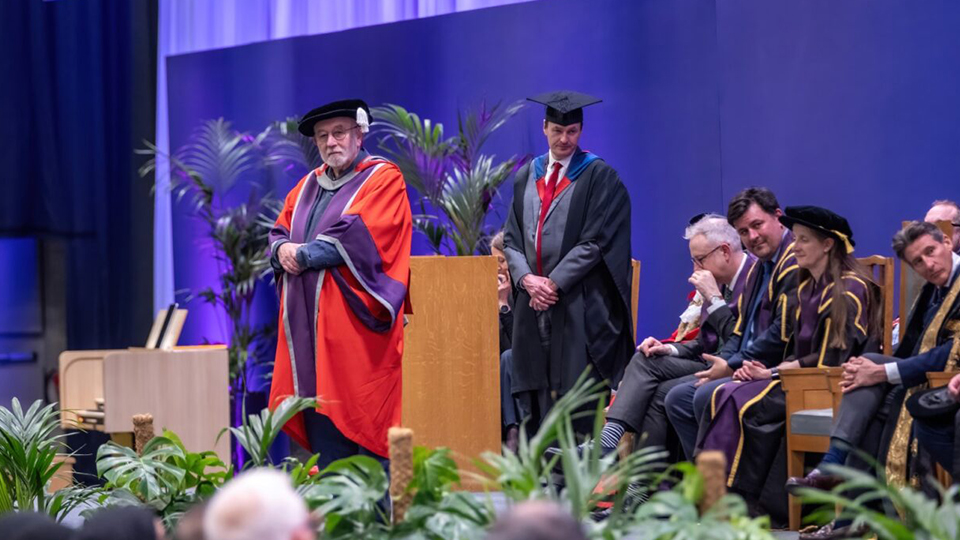Sir Michael Berry
World-famous mathematical physicist

Sir Michael Berry was awarded an Honorary Degree in Winter 2023. Here you can read his degree oration.
Chancellor
At the University, we are proud of our contributions in research and teaching in STEM subjects, and as a mathematician myself, it is a privilege to be introducing to you the world-famous mathematical physicist, Professor Sir Michael Berry.
Michael has always had a passion for science, growing up with a keen interest in astronomy. This love led him to study Physics at Exeter University, before studying for his PhD at St Andrews. His postdoctoral research in theoretical physics at Bristol University began his lifelong career at that institution, where he is now an Emeritus Professor.
Over the course of a distinguished career spanning six decades, Michael has contributed significantly to our understanding of many physical pheomona and their mathematical underpinnings. He has published several hundred research papers. His first book, The Diffraction of Light By Ultrasound, (I have a copy in my office!) was adapted from his PhD thesis and was an early example (it was published in 1966!!) of his skill in bringing sophisticated mathematical techniques to bear on problems of real physical relevance.
Unsurpisngly, in the course of his career, Michael has worked in many areas of physics but he is particularly famous for his contributions to our understanding of wave phenomena in semiclassical physics, an area that acts as a bridge between classical physics and quantum mechanics. He describes this borderland as his intellectual habitat.
He is perhaps most famous for his work on what is now known as the Berry phase, a geometric quantity that is ubiquitous in a number of physical and quantum systems that are subject to slow cyclical changes. Michael’s seminal paper on this topic was published in 1984 and there was a great deal of interest and excitement in Bristol as this work was developed over the succeeding years. I was a PhD student at Bristol back then and I can still remember attending inspiring talks given by Michael at the time.
Most of us would be more than happy to have one thing named after us, but Michael has many. If I may add one further personal anecdote: I once met Michael at a meeting and told him that I had derived a mathematical proof of something known as the Lloyd-Berry formula, which stemmed from work he had done back in the 1960s. After a brief conversation, it became clear that Michael didn’t even know that this result had his name attached to it.
As well as his cutting edge research, Michael enjoys uncovering dramatic and beautiful examples in everyday life that can be linked to abstract mathematical ideas. This includes those found in rainbows and the patterns on the bottom of swimming-pools, levitating spinning tops, tsunamis and magic mirrors.
His extraordinary work has been recognised in countless ways – not least through the knighthood that was bestowed upon him by Queen Elizabeth in 1996.
He was elected as a Fellow of the Royal Society in 1982 and he has been awarded prestigious prizes around the globe. As well as many accolades in the UK, he has been honoured in the USA, Sweden, Russia, Israel, the Netherlands and Norway, to name a few.
He was also the proud winner in the year 2000 of an Ig Nobel prize (created to honor achievements that first make people laugh, and then make them think) for work on the use of magnets to levitate frogs.
Michael has shared his work and research far and wide, delivering many guest lectures around the world. At Loughborough, we have had the pleasure of welcoming him to our School of Science to deliver several lectures, including the Sir Neville Mott Lecture in 2006, the Sir David Wallace Lecture in 2015, and most recently the Christmas Lecture in Mathematics in 2018.
Chancellor, is it my honour to present to you today Professor Sir Michael Berry, in recognition of his outstanding contribution to mathematical and theoretical physics, for the degree of Doctor of Science, honoris causa.